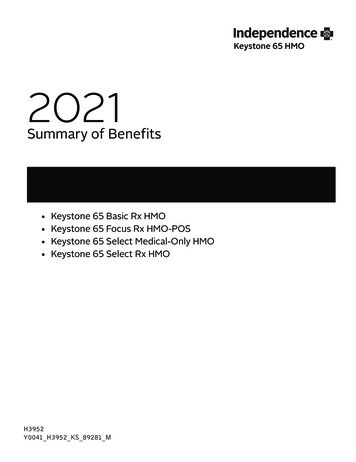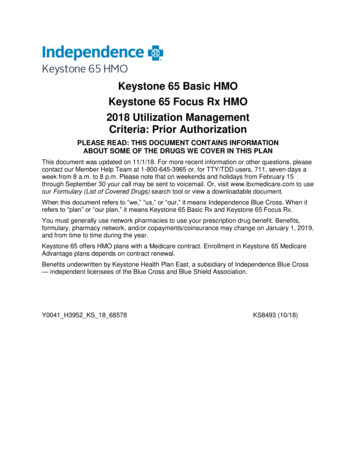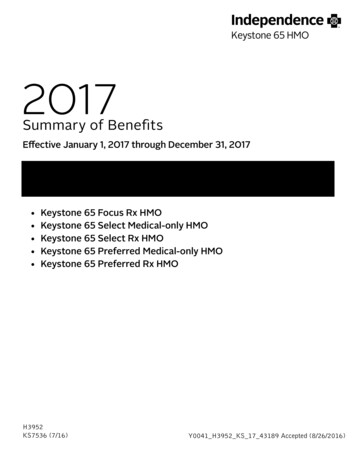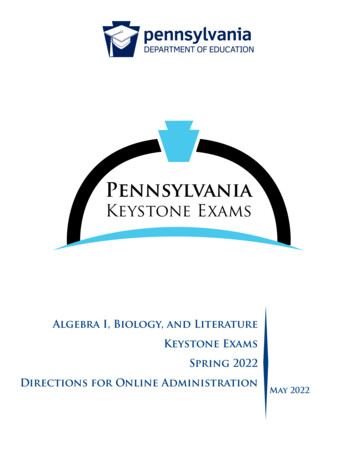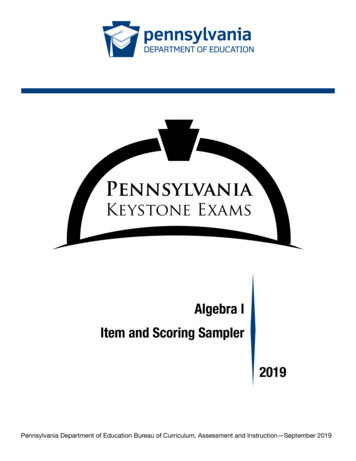
Transcription
Keystone Exams: Algebra IIAssessment Anchors and Eligible Contentwith Sample QuestionsPennsylvania Department of Educationwww.education.state.pa.us2011
PENNSYLVANIA DEPARTMENT OF EDUCATIONGeneral Introduction to the Keystone Exam Assessment AnchorsIntroductionSince the introduction of the Keystone Exams, the Pennsylvania Department of Education (PDE) has beenworking to create a set of tools designed to help educators improve instructional practices and betterunderstand the Keystone Exams. The Assessment Anchors, as defined by the Eligible Content, are one of themany tools the Department believes will better align curriculum, instruction, and assessment practicesthroughout the Commonwealth. Without this alignment, it will not be possible to significantly improve studentachievement across the Commonwealth.How were Keystone Exam Assessment Anchors developed?Prior to the development of the Assessment Anchors, multiple groups of PA educators convened to create aset of standards for each of the Keystone Exams. Enhanced standards, derived from a review of existingstandards, focused on what students need to know and be able to do in order to be college and career ready.Additionally, the Assessment Anchors and Eligible Content statements were created by other groups ofeducators charged with the task of clarifying the standards assessed on the Keystone Exams. TheAssessment Anchors, as defined by the Eligible Content, have been designed to hold together or anchor thestate assessment system and curriculum/instructional practices in schools.Assessment Anchors, as defined by the Eligible Content, were created with the following design parameters: Clear: The Assessment Anchors are easy to read and are user friendly; they clearly detail whichstandards are assessed on the Keystone Exams.Focused: The Assessment Anchors identify a core set of standards that could be reasonablyassessed on a large-scale assessment, which will keep educators from having to guess whichstandards are critical.Rigorous: The Assessment Anchors support the rigor of the state standards by assessing higherorder and reasoning skills.Manageable: The Assessment Anchors define the standards in a way that can be easilyincorporated into a course to prepare students for success.How can teachers, administrators, schools, and districts use these Assessment Anchors?The Assessment Anchors, as defined by the Eligible Content, can help focus teaching and learning becausethey are clear, manageable, and closely aligned with the Keystone Exams. Teachers and administrators willbe better informed about which standards will be assessed. The Assessment Anchors and Eligible Contentshould be used along with the Standards and the Curriculum Framework of the Standards Aligned System(SAS) to build curriculum, design lessons, and support student achievement.The Assessment Anchors and Eligible Content are designed to enable educators to determine when they feelstudents are prepared to be successful on the Keystone Exams. An evaluation of current course offerings,through the lens of what is assessed on those particular Keystone Exams, may provide an opportunity for analignment to ensure student preparedness.Pennsylvania Department of Education—Assessment Anchors and Eligible ContentPage 2
How are the Assessment Anchors organized?The Assessment Anchors, as defined by the Eligible Content, are organized into cohesive blueprints, eachstructured with a common labeling system that can be read like an outline. This framework is organized firstby module, then by Assessment Anchor, followed by Anchor Descriptor, and then finally, at the greatest levelof detail, by an Eligible Content statement. The common format of this outline is followed across theKeystone Exams.Here is a description of each level in the labeling system for the Keystone Exams: Module: The Assessment Anchors are organized into two thematic modules for each of theKeystone Exams. The module title appears at the top of each page. The module level is importantbecause the Keystone Exams are built using a module format, with each of the Keystone Examsdivided into two equally sized test modules. Each module is made up of two or more AssessmentAnchors.Assessment Anchor: The Assessment Anchor appears in the shaded bar across the top of eachAssessment Anchor table. The Assessment Anchors represent categories of subject matter thatanchor the content of the Keystone Exams. Each Assessment Anchor is part of a module and hasone or more Anchor Descriptors unified under it.Anchor Descriptor: Below each Assessment Anchor is a specific Anchor Descriptor. The AnchorDescriptor level provides further details that delineate the scope of content covered by theAssessment Anchor. Each Anchor Descriptor is part of an Assessment Anchor and has one or moreEligible Content unified under it.Eligible Content: The column to the right of the Anchor Descriptor contains the Eligible Contentstatements. The Eligible Content is the most specific description of the content that is assessed onthe Keystone Exams. This level is considered the assessment limit and helps educators identify therange of the content covered on the Keystone Exams.Enhanced Standard: In the column to the right of each Eligible Content statement is a coderepresenting one or more Enhanced Standards that correlate to the Eligible Content statement.Some Eligible Content statements include annotations that indicate certain clarifications about thescope of an Eligible Content. “e.g.” (“for example”)—sample approach, but not a limit to the Eligible Content.“Note”—content exclusions or definable range of the Eligible Content.What impact will the implementation of the K–12 Common Core Standards have on the content of thisdocument?It is anticipated that there will be significant alignment between PA’s Academic Standards and the CommonCore. Every effort will be made to ensure that the alignment of the standards to the Assessment Anchors andEligible Content is maintained. As more information becomes available, PDE will inform state educators.Standards Aligned System—www.pdesas.orgPennsylvania Department of Education—www.education.state.pa.usPennsylvania Department of Education—Assessment Anchors and Eligible ContentPage 3
Keystone Exams: Algebra IIFORMULA SHEETFormulas that you may need to work questions in this document are found below.You may use calculator π or the number 3.14.ShapesLogarithmic Propertiesloga x y x a yA lwwlog x y x 10 yIn x y x eyloga (x · y ) loga x loga ylloga x p p · loga xxloga y loga x loga yhV lwhwlQuadratic Functionsf (x) ax 2 bx cGeneral Formula:Data Analysisf (x) a(x h )2 kStandard (Vertex) Form:Permutation:nPrCombination: n!(n r)!n!nCr r!(n r)!f(x ) a(x x 1)(x x 2)Factored Form:Quadratic Formula:x ˉb b 2 4ac2awhen ax 2 bx c 0 and a Þ 0Exponential Propertiesam · an am n(a m )n a m · nam am nana 1 1aCompound Interest EquationsAnnual:A P (1 r ) tPeriodic:A P 1 i3 ii 2 1ntnP principal amountr annual rate of interestt time (years)Continuous: 1r( )Powers of the Imaginary Uniti A account total after t yearsA Pertn number of periods interestis compounded per yeari4 1Pennsylvania Department of Education—Assessment Anchors and Eligible ContentPage 4
Keystone Exams: Algebra IIMODULE 1—Number Systems and Non-Linear Expressions & EquationsASSESSMENT ANCHORA2.1.1Operations with Complex NumbersA2.1.1.1EnhancedStandardAnchor DescriptorEligible ContentRepresent and/or useimaginary numbersin equivalent forms(e.g., square roots andexponents).A2.1.1.1.1Simplify/write square roots in terms of i}}(e.g., Ï-24 2iÏ6 ).2.1.A2.AA2.1.1.1.2Simplify/evaluate expressions involvingpowers of i (e.g., i6 i3 -1 – i).2.2.A2.CSample Exam QuestionsStandard A2.1.1.1.1}The expression Ïx Ïy is equivalent to 4iÏ7 . Whichcould be the values of x and y?}}Standard A2.1.1.1.2An expression is shown below.x5 6x3 8xA. x –16y –7Which value of x makes the expression equal to 0?B. x 14y 8A. –2i2C. x 16iy 7C. 4iD. x 14y –8B. –2iD. 4i2Pennsylvania Department of Education—Assessment Anchors and Eligible ContentPage 5
Keystone Exams: Algebra IIMODULE 1—Number Systems and Non-Linear Expressions & EquationsASSESSMENT ANCHORA2.1.1Operations with Complex NumbersA2.1.1.2Anchor DescriptorEligible ContentEnhancedStandardApply the orderof operations incomputation andin problem-solvingsituations.A2.1.1.2.1Add and subtract complex numbers(e.g., (7 – 3i ) – (2 i ) 5 – 4i ).2.2.A2.CA2.1.1.2.2Multiply and divide complex numbers(e.g., (7 – 3i )(2 i ) 17 i ).2.2.A2.CSample Exam QuestionsStandard A2.1.1.2.1An equation with real numbers b, c, d, and e isshown below.Standard A2.1.1.2.2An equation is shown below.(a bi )(4 – 2i ) 40(4i bc) – (6i de) –2iWhat is the value of b?Which relationship must be true?A. 2A. bc –deB. bc deC. b dB. 4C. 10D. 20D. (b – d) (c – e)Pennsylvania Department of Education—Assessment Anchors and Eligible ContentPage 6
Keystone Exams: Algebra IIMODULE 1—Number Systems and Non-Linear Expressions & EquationsASSESSMENT ANCHORA2.1.1Operations with Complex NumbersSample Exam QuestionsStandard A2.1.1Lily is practicing multiplying complex numbers using the complex number (2 i ).To determine the value of (2 i )2, Lily performs the following operations:step 1:(2 i )2 4 i2step 2:4 i2 4 (–1)step 3:4 (–1) 3Lily made an error.A.Explain Lily’s error and correct the step which contains her error.Lily says that (2 i )n is a complex number for every positive integer value of n.B.Explain how you know that Lily is correct.Continued next pagePennsylvania Department of Education—Assessment Anchors and Eligible ContentPage 7
Keystone Exams: Algebra IIMODULE 1—Number Systems and Non-Linear Expressions & EquationsContinued. Please refer to the previous page for task explanation.Lily is continuing to explore different ways in which complex numbers can be multiplied so the answeris not a complex number. Lily multiplies (2 i ) and (a bi ), where a and b are real numbers, and findsthat her answer is not a complex number.C.Write an equation that expresses the relationship between a and b.equation:D.Explain why the expression (c di )2 is always a complex number for nonzero, real values ofc and d.Pennsylvania Department of Education—Assessment Anchors and Eligible ContentPage 8
Keystone Exams: Algebra IIMODULE 1—Number Systems and Non-Linear Expressions & EquationsStandard A2.1.1To find the roots of a quadratic equation, ax2 bx c, where a, b, and c are real numbers, Jan uses thequadratic formula.Jan finds that a quadratic equation has 2 distinct roots, but neither are real numbers.A.Write an inequality using the variables a, b, and c that must always be true for Jan’squadratic equation.inequality:}–The expression 3 Ï 4 is a solution of the quadratic equation x2 – 6x 13 0.B.}–What is 3 Ï 4 written as a complex number?}–3 Ï4 Continued next pagePennsylvania Department of Education—Assessment Anchors and Eligible ContentPage 9
Keystone Exams: Algebra IIMODULE 1—Number Systems and Non-Linear Expressions & EquationsContinued. Please refer to the previous page for task explanation.C.What is (5 2i )2 expressed as a complex number?(5 2i )2 D.}}What is a possible solution to the equation 5 Ï (a – bi )(a bi ) when a and b are whole numbersgreater than zero?a b Pennsylvania Department of Education—Assessment Anchors and Eligible ContentPage 10
Keystone Exams: Algebra IIMODULE 1—Number Systems and Non-Linear Expressions & EquationsASSESSMENT ANCHORA2.1.2Non-Linear ExpressionsA2.1.2.1Anchor DescriptorEligible ContentEnhancedStandardUse exponents, roots,and/or absolute valuesto represent equivalentforms or to solveproblems.A2.1.2.1.1Use exponential expressions to representrational numbers.2.1.A2.DA2.1.2.1.2Simplify/evaluate expressions involvingpositive and negative exponents and/orroots (may contain all types of realnumbers—exponents should not exceedpower of 10).2.2.A2.CSample Exam QuestionsStandard A2.1.2.1.11 ?Which expression is equivalent to25Standard A2.1.2.1.2An expression is shown below.8-8x x-2A. 4 10B. 25 10-2C. 4 10-1D. 25 10-15 x 5xWhich value of x makes the expression equal to 1}?2A. 0B. 1C. 2D. 4Pennsylvania Department of Education—Assessment Anchors and Eligible ContentPage 11
Keystone Exams: Algebra IIMODULE 1—Number Systems and Non-Linear Expressions & EquationsASSESSMENT ANCHORA2.1.2Non-Linear ExpressionsA2.1.2.1Anchor DescriptorEligible ContentEnhancedStandardUse exponents, roots,and/or absolute valuesto represent equivalentforms or to solveproblems.A2.1.2.1.3Simplify/evaluate expressions involvingmultiplying with exponents(e.g., x6 x7 x13), powers of powers(e.g., (x6)7 x42) and powers of products(e.g., (2x2)3 8x6).Note: Limit to rational exponents.2.2.A2.CA2.1.2.1.4Simplify or evaluate expressions involvinglogarithms and exponents (e.g., log28 3or log42 1}2).2.1.A2.FSample Exam QuestionsStandard A2.1.2.1.3Standard A2.1.2.1.4–4log–x10n(x5 (x 5 )n) x 10Which is the value of n?A. –3An expression is shown below.An equation is shown below.16x y4What is the value of the expression when log x 8and log y 1?A. 7B. 15B. –1C. 16D. 311C. – }2D. 2Pennsylvania Department of Education—Assessment Anchors and Eligible ContentPage 12
Keystone Exams: Algebra IIMODULE 1—Number Systems and Non-Linear Expressions & EquationsASSESSMENT ANCHORA2.1.2Non-Linear ExpressionsA2.1.2.2Anchor DescriptorEligible ContentEnhancedStandardSimplify expressionsinvolving polynomials.A2.1.2.2.1Factor algebraic expressions, includingdifference of squares and trinomials.Note: Trinomials limited to the formax2 bx c where a is not equal to 0.2.1.A2.BA2.1.2.2.2Simplify rational algebraic expressions.2.1.A2.BSample Exam QuestionsStandard A2.1.2.2.1An expression is shown below.Standard A2.1.2.2.2An expression is shown below.23x – 4x – 15 ; x Þ – 1, 3}26x2 – 19x 10Which is a factor of the expression?A. 2x 2B. 2x 5C. 3x – 22x –5x – 32Which expression is equivalent to the one shown?3x 5A.2x 1–5B. 3x}2x – 1D. 3x – 5C. x2 x – 12D. 5x2 – 9x – 18Pennsylvania Department of Education—Assessment Anchors and Eligible ContentPage 13
Keystone Exams: Algebra IIMODULE 1—Number Systems and Non-Linear Expressions & EquationsASSESSMENT ANCHORA2.1.2Non-Linear ExpressionsSample Exam QuestionsStandard A2.1.2The expression (10d)3/2 is used to find how many times more energy is released by an earthquake ofgreater magnitude than by an earthquake of lesser magnitude where d is the difference in magnitudes.A.How many times more energy is given off by an earthquake with magnitude 5.2 than by anearthquake with magnitude 3.2?times more energy:B.What is the difference, d, when 100 times more energy is released by an earthquake of greatermagnitude than by an earthquake of lesser magnitude?d Continued next pagePennsylvania Department of Education—Assessment Anchors and Eligible ContentPage 14
Keystone Exams: Algebra IIMODULE 1—Number Systems and Non-Linear Expressions & EquationsContinued. Please refer to the previous page for task explanation.C.What is an equivalent exponential expression to (10d)3/2 with a base of 1000?equivalent exponential expression:D.}Explain why (Ï 10 )3d is equivalent to (10d)3/2.Pennsylvania Department of Education—Assessment Anchors and Eligible ContentPage 15
Keystone Exams: Algebra IIMODULE 1—Number Systems and Non-Linear Expressions & EquationsStandard A2.1.2Beatriz is simplifying exponential and radical expressions.A.3What rational number is the result of simplifying 16-3/2 ?rational number:The exponential expression 52x 3 can be simplified to the form a(bx) where a and b are integers.B.What are the values of a and b?a b Continued next pagePennsylvania Department of Education—Assessment Anchors and Eligible ContentPage 16
Keystone Exams: Algebra IIMODULE 1—Number Systems and Non-Linear Expressions & EquationsContinued. Please refer to the previous page for task explanation.The variable c represents a whole number between 1 and 100. The values of the expressions c1/2 andc2/3 are both whole numbers for only one value of c.C.What whole number does c represent?c Pennsylvania Department of Education—Assessment Anchors and Eligible ContentPage 17
Keystone Exams: Algebra IIMODULE 1—Number Systems and Non-Linear Expressions & EquationsASSESSMENT ANCHORA2.1.3Non-Linear EquationsAnchor DescriptorA2.1.3.1EnhancedStandardEligible ContentWrite and/or solve non- A2.1.3.1.1linear equations usingvarious methods.A2.1.3.1.2Write and/or solve quadratic equations(including factoring and using theQuadratic Formula).2.8.A2.B2.8.A2.E2.8.A2.FSolve equations involving rational and/orradical expressions(e.g., 10/(x 3) 12/(x – 2) 1 or}Ïx2 21x 14).2.8.A2.B2.8.A2.E2.8.A2.FSample Exam QuestionsStandard A2.1.3.1.1Standard A2.1.3.1.2The equation x2 bx c 0 has exactly 1 realsolution when b and c are real numbers. Whichequation describes b in terms of c?An equation is shown below.A. b c2What is the solution set of the equation?}48xB. b ÏcA. {–7, –1}C. b 2cB. {–7, 1}}D. b 2Ïc364x 8x x2 83C. {–1, 7}D. {1, 7}Pennsylvania Department of Education—Assessment Anchors and Eligible ContentPage 18
Keystone Exams: Algebra IIMODULE 1—Number Systems and Non-Linear Expressions & EquationsASSESSMENT ANCHORA2.1.3Non-Linear EquationsAnchor DescriptorA2.1.3.1Eligible ContentWrite and/or solve non- A2.1.3.1.3linear equations usingvarious methods.A2.1.3.1.4EnhancedStandardWrite and/or solve a simple exponential orlogarithmic equation (including commonand natural logarithms).2.1.A2.F2.8.A2.E2.8.A2.FWrite, solve, and/or apply linear orexponential growth or decay (includingproblem situations).2.11.A2.BSample Exam QuestionsStandard A2.1.3.1.3Standard A2.1.3.1.4An equation is shown below.35x 92x – 1A patient is given a 100-milligram dosage of a drugthat decays exponentially, with a half-life of 6 hours.Which equation could be used to find the milligramsof drug remaining, y, after x hours?Which equation has the same solution?A. y 100(6)0.5xA. 3x 10x – 5B. 5x 4x – 2C. 8x 11x – 1B. y 100(x)0.5/6C. y 100(0.5)x/6D. y 100(0.5x)1/6D. 15x 18x – 9Pennsylvania Department of Education—Assessment Anchors and Eligible ContentPage 19
Keystone Exams: Algebra IIMODULE 1—Number Systems and Non-Linear Expressions & EquationsASSESSMENT ANCHORA2.1.3Non-Linear EquationsA2.1.3.2Anchor DescriptorEligible ContentEnhancedStandardDescribe and/ordetermine change.A2.1.3.2.1Determine how a change in one variablerelates to a change in a second variable(e.g., y 4/x; if x doubles, what happensto y?).2.3.A2.EA2.1.3.2.2Use algebraic processes to solve aformula for a given variable(e.g., solve d rt for r).2.3.A2.CSample Exam QuestionsStandard A2.1.3.2.1Standard A2.1.3.2.2A moving object’s kinetic energy, Ek, is dependenton the mass of the object, m, and the object’svelocity, v, as shown in the equation below.Physicists use the formula shown below todetermine total energy (E) of a body by usingmomentum (p), mass (m), and the speed of light (c).}}1 mv2Ek 2How does the value of Ek change when the valueof m is unchanged and the value of v is multipliedby 2?A. The value of Ek is squared.B. The value of Ek is multiplied by 2.C. The value of Ek is multiplied by 4.D. The value of Ek is multiplied by 8.E Ï(pc)2 (mc2)2A physicist knows the speed of light, the mass ofthe body, and the total energy used by the body.Which formula could be used to determine themomentum of the body?}E2 – m2c4A. p Ï}c}E – mc2B. p Ï}cE – mcC. p cD. p E – mcPennsylvania Department of Education—Assessment Anchors and Eligible ContentPage 20
Keystone Exams: Algebra IIMODULE 1—Number Systems and Non-Linear Expressions & EquationsASSESSMENT ANCHORA2.1.3Non-Linear EquationsSample Exam QuestionsStandard A2.1.3Michaela is solving rational equations.A.B.x2 – 7x 12 3? Show or explain all your work.What is the solution set of the equationx2 x – 122 bx – 18 4 is x –17. What is the value of b?The only solution of the equation x}}–2x 4b Continued next pagePennsylvania Department of Education—Assessment Anchors and Eligible ContentPage 21
Keystone Exams: Algebra IIMODULE 1—Number Systems and Non-Linear Expressions & EquationsContinued. Please refer to the previous page for task explanation.Michaela solved for x in the rational equation as shown below.2x 2x – 15 3x–3x2 2x – 15 3 (x – 3)(x – 3) x–3x2 2x – 15 3x – 9x2 – x – 6 0(x – 3)(x 2) 0x – 3 0 or x 2 0x {3, –2}The solution set for x is incorrect.C.Explain Michaela’s error.Pennsylvania Department of Education—Assessment Anchors and Eligible ContentPage 22
Keystone Exams: Algebra IIMODULE 1—Number Systems and Non-Linear Expressions & EquationsStandard A2.1.3A fully-charged lithium-ion computer battery loses 20% of its permanent capacity each year of storage.A.Write an exponential equation showing the capacity, c, remaining in a fully-charged lithium-ioncomputer battery after y years.c B.What capacity is remaining in a fully-charged lithium-ion battery after 1.5 years?capacity:Continued next pagePennsylvania Department of Education—Assessment Anchors and Eligible ContentPage 23
Keystone Exams: Algebra IIMODULE 1—Number Systems and Non-Linear Expressions & EquationsContinued. Please refer to the previous page for task explanation.C.Solve the exponential equation from part A for y.y D.For how many years will a fully-charged lithium-ion computer battery have been stored when it haslost exactly half of its capacity?years:Pennsylvania Department of Education—Assessment Anchors and Eligible ContentPage 24
Keystone Exams: Algebra IIMODULE 2—Functions and Data AnalysisASSESSMENT ANCHORA2.2.1Patterns, Relations, and FunctionsA2.2.1.1Anchor DescriptorEligible ContentEnhancedStandardAnalyze and/or usepatterns or numbers.A2.2.1.1.1Analyze a set of data for the existence ofa pattern and represent the pattern with arule algebraically and/or graphically.2.8.A2.CA2.2.1.1.2Identify and/or extend a pattern as either2.8.A2.Can arithmetic or geometric sequence(e.g., given a geometric sequence, find the20th term).Sample Exam QuestionsStandard A2.2.1.1.1Terms 1 through 5 of a pattern are listed below.Standard A2.2.1.1.2Terms 1 through 5 of a sequence are shown below.8}814 3 4 7 12The pattern continues. Which expression could beused to determine the nth term in the pattern?A. 2n 2B. Zn – 2Z 3C. n2 – 4n 7D. n3 – 5n2 7n 14}272}91}31}2What is the 10th term in the sequence?81A. }64B. 81}32C. 243}64243D.32Pennsylvania Department of Education—Assessment Anchors and Eligible ContentPage 25
Keystone Exams: Algebra IIMODULE 2—Functions and Data AnalysisASSESSMENT ANCHORA2.2.1Patterns, Relations, and FunctionsA2.2.1.1EnhancedStandardAnchor DescriptorEligible ContentAnalyze and/or usepatterns or relations.A2.2.1.1.3Determine the domain, range, or inverse of 2.8.A2.Da relation.A2.2.1.1.4Identify and/or determine thecharacteristics of an exponential,quadratic, or polynomial function(e.g., intervals of increase/decrease,intercepts, zeros, and asymptotes).2.8.A2.DSample Exam QuestionsStandard A2.2.1.1.3Standard A2.2.1.1.4What is the inverse of y ln (x – 15) 3?When is f(x) x2 – x – 12 increasing?A. y ex – 3 151A. x }2B. y e 12xC. y ex 12 15D. y ex – 15 3B. x 1}2C. x –3D. x 4Pennsylvania Department of Education—Assessment Anchors and Eligible ContentPage 26
Keystone Exams: Algebra IIMODULE 2—Functions and Data AnalysisASSESSMENT ANCHORA2.2.1Patterns, Relations, and FunctionsSample Exam QuestionsStandard A2.2.1The path of a roller coaster after it has reached the top of the first hill follows a polynomial function, f(x), asshown in the graph below.Path of a Roller Coasterf(x)Height (in feet)3002001000100200300400500xDistance (in feet)Continued next pagePennsylvania Department of Education—Assessment Anchors and Eligible ContentPage 27
Keystone Exams: Algebra IIMODULE 2—Functions and Data AnalysisContinued. Please refer to the previous page for task explanation.A.Over what interval is f(x) increasing? x B.At what value of x is there a minimum of f(x) over the interval 0 x 300?value of x:Continued next pagePennsylvania Department of Education—Assessment Anchors and Eligible ContentPage 28
Keystone Exams: Algebra IIMODULE 2—Functions and Data AnalysisContinued. Please refer to the previous page for task explanation.C.At what value of x is there a zero of f(x)?value of x:D.Explain why f(x) cannot be a quadratic function.Pennsylvania Department of Education—Assessment Anchors and Eligible ContentPage 29
Keystone Exams: Algebra IIMODULE 2—Functions and Data AnalysisStandard A2.2.1The function below describes the graph of a quadratic function where c is a positive real number.y x2 – cA.What are the x-intercept(s) of the graph of the quadratic function?x-intercept(s):B.What is a y-value, in terms of c, which cannot be in the range of the quadratic function?y-value:Continued next pagePennsylvania Department of Education—Assessment Anchors and Eligible ContentPage 30
Keystone Exams: Algebra IIMODULE 2—Functions and Data AnalysisContinued. Please refer to the previous page for task explanation.C.What is the domain of the inverse of the quadratic function?domain of the inverse of the quadratic function:Pennsylvania Department of Education—Assessment Anchors and Eligible ContentPage 31
Keystone Exams: Algebra IIMODULE 2—Functions and Data AnalysisASSESSMENT ANCHORA2.2.2Applications of FunctionsA2.2.2.1Anchor DescriptorEligible ContentEnhancedStandardCreate, interpret,and/or use polynomial,exponential, and/orlogarithmic functionsand their equations,graphs, or tables.A2.2.2.1.12.8.A2.BA2.2.2.1.2Create, interpret, and/or use the equation,graph, or table of a polynomial function(including quadratics).Create, interpret, and/or use the equation,graph, or table of an exponential orlogarithmic function (including commonand natural logarithms).2.8.A2.BSample Exam QuestionsStandard A2.2.2.1.1Standard A2.2.2.1.2The table below represents a quadratic function.xf(x)53401308115A logarithmic function is graphed below.f(x)4321– 4 – 3 – 2 –1–1–2–3–4Which describes a complete list where the zeros off(x) occur?1 2 3 4xA. x 8 and x 4B. x 4 and x 2C. x –8 and x –4What is the value of f(8)?D. x –4 and x –2A. 3B. 4C. 16D. 256Pennsylvania Department of Education—Assessment Anchors and Eligible ContentPage 32
Keystone Exams: Algebra IIMODULE 2—Functions and Data AnalysisASSESSMENT ANCHORA2.2.2Applications of FunctionsA2.2.2.1Anchor DescriptorEligible ContentEnhancedStandardCreate, interpret,and/or use polynomial,exponential, and/orlogarithmic functionsand their equations,graphs, or tables.A2.2.2.1.32.11.A2.AA2.2.2.1.4Determine, use, and/or interpret minimumand maximum values over a specifiedinterval of a graph of a polynomial,exponential, or logarithmic function.Translate a polynomial, exponential,or logarithmic function from onerepresentation of a function to another(graph, table, and equation).2.8.A2.B2.8.A2.ESample Exam QuestionsStandard A2.2.2.1.3A function of x is shown below.Standard A2.2.2.1.4A function of x is graphed below.yy –3(x – 2)(x 4)What is the maximum value of the function over theinterval –3 x 2?8642A. 0B. 15C. 24D. 27– 8 – 6 – 4 –2–2–4–6–82 4 6 8xWhich equation best describes the graph?A. y x2 5B. y (x – 2)2 1C. y (x 2)2 1D. y (x 2)(x – 1)Pennsylvania Department of Education—Assessment Anchors and Eligible ContentPage 33
Keystone Exams: Algebra IIMODULE 2—Functions and Data AnalysisASSESSMENT ANCHORA2.2.2Applications of FunctionsA2.2.2.2Anchor DescriptorEligible ContentDescribe and/ordetermine families offunctions.A2.2.2.2.1Identify or describe the effect of changingparameters within a family of functions(e.g., y x2 and y x2 3, or y x2 andy 3x2).EnhancedStandard2.3.A2.E2.8.A2.DSample Exam QuestionStandard A2.2.2.2.1The graph of the equation y 3x2 has its vertex atthe coordinate point (0, 0). What coordinate pointdescribes the vertex of the graph of the equationy 3x2 – 3?A. (0, –3)B. (0, 3)C. (–3, 0)D. (3, 0)Pennsylvania Department of Education—Assessment Anchors and Eligible ContentPage 34
Keystone Exams: Algebra IIMODULE 2—Functions and Data AnalysisASSESSMENT ANCHORA2.2.2Applications of FunctionsSample Exam QuestionsStandard A2.2.2An exponential function of the form f(x) a bx c is represented by the pairs of values shown in thetable below.xf(x)21215113501512A.53527Determine the exponential function, f(x), that contains the 5 points shown in the table.f(x) Continued next pagePennsylvania Department of Education—Assessment Anchors and Eligible ContentPage 35
Keystone Exams: Algebra IIMODULE 2—Functions and Data AnalysisContinued. Please refer to the previous page for task explanation.B.What is the minimum value of f(x) over the interval –5 x 5?minimum:C.Describe the difference in the graph of the exponential function g(x) a bx 2 c and the graph ofthe exponential function f(x) a bx c when a, b, and c remain unchanged.Continued next pagePennsylvania Department of Education—Assessment Anchors and Eligible ContentPage 36
Keystone Exams: Algebra IIMODULE 2—Functions and Data AnalysisContinued. Please refer to the previous page for task explanation.D.What is the value of g(0)?g(0) Pennsylvania Department of Education—Assessment Anchors and Eligible ContentPage 37
Keystone Exams: Algebra IIMODULE 2—Functions and Data AnalysisStandard A2.2.2The number of meals a restaurant serves is a function of the price of each meal. The restaurant found it willserve 72 meals when it charges a price of 7.00 per meal. It will serve 52 meals when it charges a price of 12.00 per meal. The relationship between the nu
Enhanced standards, derived from a review of existing standards, focused on what students need to know and be able to do in order to be college and career ready. . Keystone Exams: Algebra II MODULE 1—Number Systems and Non-Linear Expressions & Equations Standard A2.1.1 To find the roots of a quadratic equation, .
